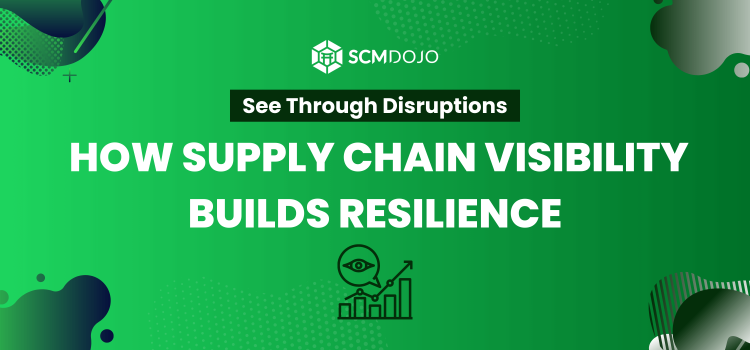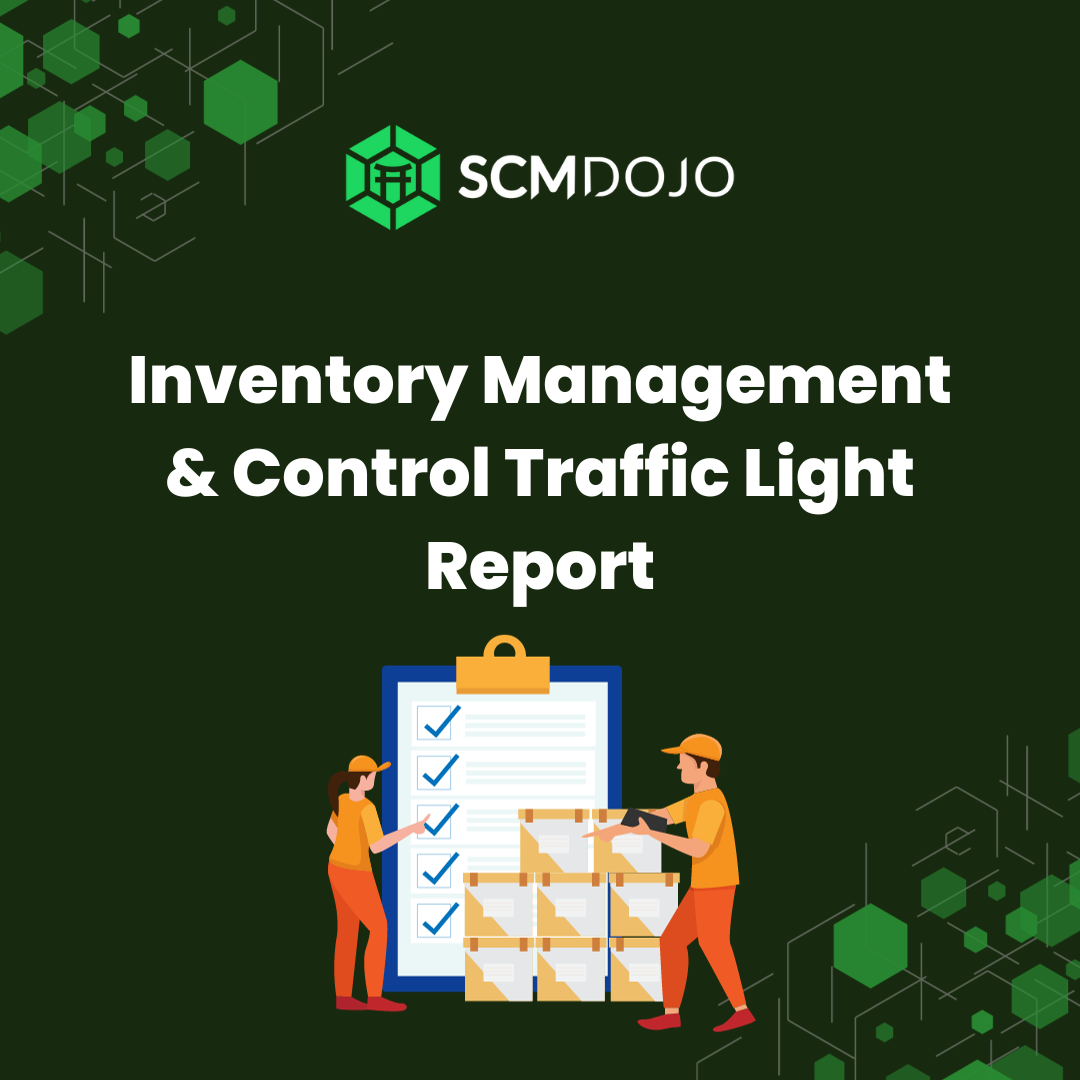Supply chains are vital to businesses, facilitating the movement of goods, services, financial flows, and information. However, they are also susceptible to disruptions and risks. Enhancing supply chain resilience as well as supply chain visibility is crucial in today’s interconnected world.
Supply Chain Resilience refers to a supply chain’s ability to withstand and recover from unexpected events. The powerful concept of Supply Chain Visibility lies at the core of resilience.
Watch the Mastering Supply Chain Resilience: Understanding Economic Volatility and Transformation course overview video on our SCMDOJO YouTube channel!
Supply Chain Visibility refers to tracking and monitoring the movement of goods, services, and information throughout the supply chain. Just imagine having an interactive map or x-ray vision that allows you to see through the complexities of your supply chain.
Supply chain visibility can be categorized into two main types: structural and dynamic, each playing a pivotal role in enhancing supply chain resilience and operational efficiency.
Structural Visibility: Unveiling the Foundation of Supply Chains
Structural visibility refers to the ability to gain insights into the foundational elements of the supply chain network. Like a master architect, this powerful tool unveils the hidden physical infrastructure, supplier relationships, and overall network design that form the bedrock of supply chains.
This visibility enables organizations to optimize their supply chain network, manage suppliers effectively, and ensure compliance with regulations. By analyzing the current state of operations, organizations can identify opportunities to reduce waste, improve cycle times, and implement process improvements. Structural visibility allows organizations to operate more efficiently.
For example, one production company mapped their second tier of suppliers and realized that all of their strategic suppliers for a particular direct material sourced some components from a single production site, making them dependent on one source. By having visibility into their supply chain, the company could identify this potential risk and take proactive measures to mitigate it.
Benefits of Structural Visibility:
Network Optimization:
Imagine optimizing your supply chain network like a skilled cartographer, strategically plotting the most efficient locations for suppliers, warehouses, and distribution centers.
For example, a global retailer used structural visibility to identify an opportunity to relocate their distribution centers closer to major transportation hubs. This simple but strategic move resulted in significant cost savings and faster order fulfillment for delighted customers.
Supplier Relationship Management:
Structural visibility empowers organizations to forge and manage robust relationships with suppliers. By gaining insights into supplier capabilities, performance, and reliability, you can make informed decisions that drive innovation, reduce risks, and build a network of trusted partners.
Consider a manufacturing company that leveraged structural visibility to identify suppliers with specialized expertise in sustainable materials. By nurturing these relationships, they not only aligned with their sustainability goals but also gained a competitive edge in the market.
Compliance and Risk Management:
Monitor suppliers’ adherence to ethical practices, environmental regulations, and labor standards, ensuring your supply chain operates with integrity and resilience.
For example, a fashion brand that used structural visibility to verify that its suppliers met stringent labor standards. By ensuring compliance, they safeguarded their brand reputation, avoided legal complications, and built trust with conscious consumers.
Dynamic Visibility: Illuminating the Evolving Supply Chain Landscape
Thanks to the exciting dynamic visibility feature immerse yourself in the world of real-time analytical information and dynamic decision-making. Like a vigilant guardian, you closely monitor your supply chains.
Dynamic visibility involves tracking not only the movement of goods, but also monitoring inventory levels, and gaining insights into demand fluctuations, production processes, and transportation activities. This visibility empowers organizations to make data-driven decisions, align demand and supply, and proactively resolve issues in the supply chain. By leveraging dynamic visibility, organizations can optimize the movement of goods, simulate scenarios, and identify potential risks in real time.
For instance, let’s consider a company that relies heavily on a specific transportation route that is prone to flooding during the rainy season. With dynamic visibility, they can monitor weather patterns and receive alerts about potential flooding in real time. Armed with this information, they can proactively reroute shipments to alternative routes or adjust delivery schedules to avoid areas that are affected by the flood.
Benefits of Dynamic Visibility:
Real-time Decision-making:
With dynamic visibility, you can optimize inventory levels, prevent stockouts, and adjust production schedules on the fly. Seamlessly adapt to sudden changes in demand or supply, ensuring customer satisfaction and minimizing operational disruptions.
Consider a global manufacturer that leveraged dynamic visibility to monitor inventory levels across their distribution centers. By accurately predicting demand fluctuations, they optimized their inventory levels, reducing carrying costs and improving order fulfillment rates.
Demand and Supply Alignment:
Gain deep insights into customer preferences, market trends, and demand fluctuations. This empowers you to adjust production levels, optimize inventory, and ensure timely order fulfillment.
For instance, a consumer goods company harnessed dynamic visibility to detect a surge in demand for a specific product line. By swiftly responding to this real-time insight, they ramped up production and prevented stockouts. Moreover, they also capitalize on the opportunity to capture market share.
Proactive Issue Resolution:
With dynamic visibility, monitoring KPIs such as on-time delivery rates, order fulfillment rates, and production cycle times becomes easy. Detect bottlenecks, inefficiencies, and potential disruptions, taking proactive measures to address them and enhance supply chain resilience.
Imagine a logistics company that utilized dynamic visibility to identify a bottleneck in its transportation network. By managing shipments in real-time, delivery times were improved, and reduced costs. In addition, this ensures smooth operations and customer satisfaction.
Supply Chain Traceability: Unraveling the Mystery
If visibility is the map, then traceability is the breadcrumb trail. Traceability is closely related to visibility. It focuses on capturing specific and accurate online information about the movement of goods and services through the supply chain. Moreover, It focuses on documenting and tracing the journey of a product or component from its origin to the end consumer. With traceability, you become the master detective, piecing together the origin, location, and history of products.
For example, during the COVID-19 pandemic, companies with strong visibility and traceability capabilities throughout the end-to-end supply chain were able to reroute shipments, find alternative suppliers, and adjust production plans to mitigate the impact of lockdowns and border restrictions.
Benefits of Supply Chain Traceability:
- Quality Control: Traceability helps identify and address quality issues by tracking the origin and history of products. This enables organizations to quickly identify the source of problems and take appropriate actions.
- Compliance: Traceability ensures compliance with regulations and standards related to product safety, ethical sourcing, and sustainability. It demonstrates due diligence and accountability in the supply chain.
- Consumer Trust: Providing traceability information builds trust and loyalty with consumers. It allows them to verify product authenticity, understand production processes, and ensure ethical and sustainable practices.
Read more about Mastering Agility and Resilience in Your Supply Chain on our SCMDOJO website!
Conclusion:
Supply chain visibility is essential for enhancing resilience. Structural visibility provides a solid foundation by optimizing network design, managing supplier relationships, and ensuring compliance. Dynamic visibility takes you on a mesmerizing journey of real-time insights, enabling agile decision-making, demand-supply alignment, and proactive issue resolution. Organizations can achieve structural and dynamic visibility by leveraging technologies like IoT, blockchain, AI, and cloud computing, establishing robust traceability systems, and optimizing operations. Moreover, prioritizing investments in these areas enables organizations to navigate uncertainties, meet customer demands, and drive long-term success.
In my comprehensive training program on Supply Chain Visibility, developed in collaboration with SCMDOJO, I delve into the intricacies of various tools and instruments that greatly enhance and optimize Supply Chain Visibility.
About the Author – Vera Rozanova
 Vera is a seasoned procurement & supply chain professional with 25+ years of experience in Planning, Supply Chain, Procurement, SOP+, and Quality across diverse industries. She holds a degree of MBA and MCIPS. She has PRINCE2, SGS Food Safety, and Cambridge SDG&Law certificates. Vera has worked in major Multi-National Companies like Royal Canin (MARS), British American Tobacco, Procter & Gamble, and RosAgro as a procurement director.
Vera is a seasoned procurement & supply chain professional with 25+ years of experience in Planning, Supply Chain, Procurement, SOP+, and Quality across diverse industries. She holds a degree of MBA and MCIPS. She has PRINCE2, SGS Food Safety, and Cambridge SDG&Law certificates. Vera has worked in major Multi-National Companies like Royal Canin (MARS), British American Tobacco, Procter & Gamble, and RosAgro as a procurement director.
Moreover, she is an invited lecturer and Award-Winning Speaker, nominated for the ‘Best Procurement CPOs – Russia’ list. She has delivered programs on “Supply Chain Resilience,” “Risk Management,” “Procurement Digitalization”, “Procurement Transformation”, “Category Strategies”, “SRM,” and other topics. In addition, Vera brings extensive expertise to the role of a consultant/coach/mentor in procurement & supply chain, women leadership, negotiations, and soft skills.
Connect with her on LinkedIn! or Hire her as an expert!






